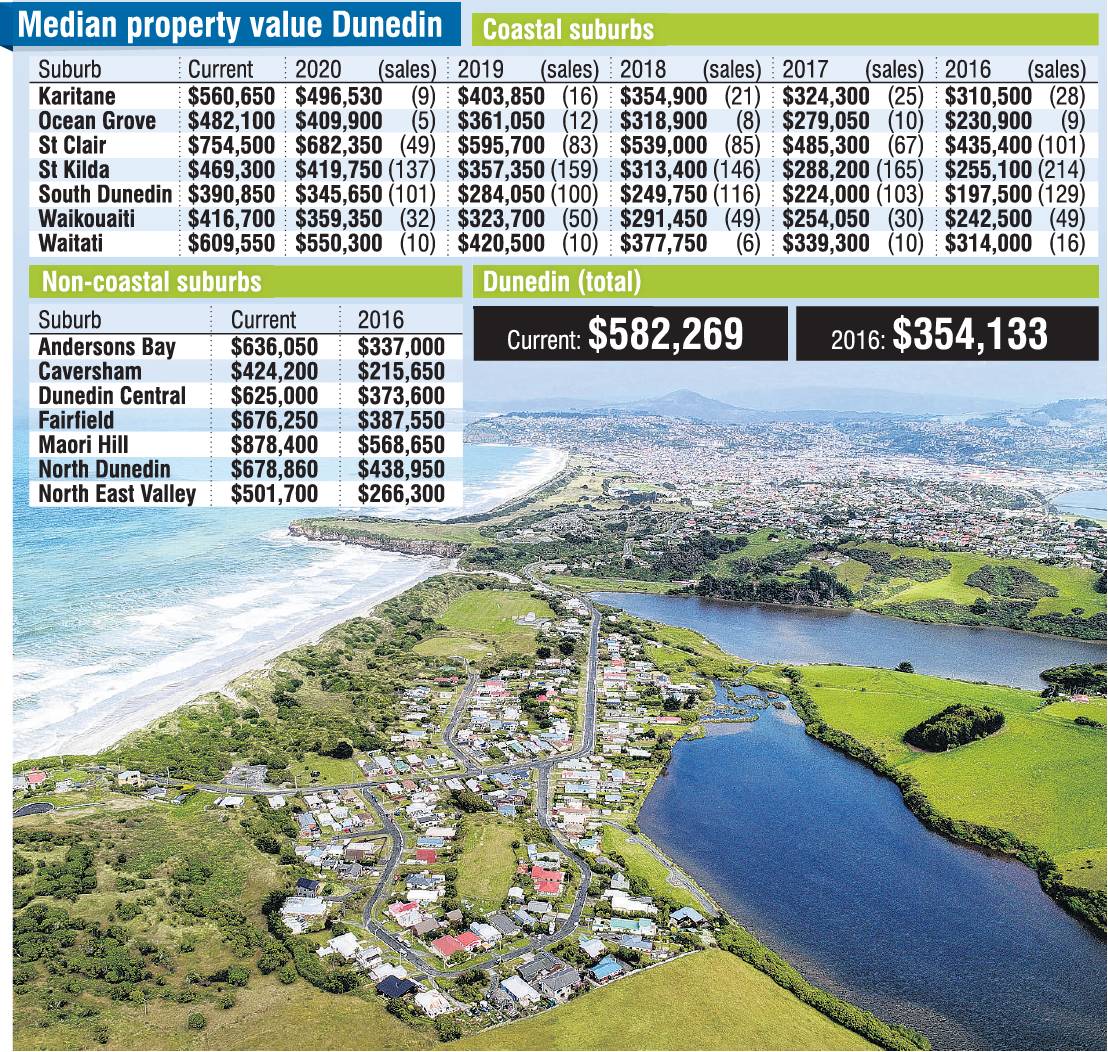
Dunedin is often cited as home to some of the most vulnerable land in New Zealand as sea levels rise around the country.
Nevertheless, CoreLogic data for the city shows over the past five years concerns about coastal properties have not been a factor for buyers.
Most properties in the city, including seaside suburbs, have recorded significant value increases and the number of sales across all suburbs has remained steady.
Otago Property Investors Association president Kathryn Seque said there was definitely still a higher demand for coastal-type properties in the city, many of which were more affordable after being inundated in the 2015 flooding.
Investors still wanted into the market in South Dunedin, St Kilda and St Clair, while prices had jumped in hill suburbs such as Mornington, Waverley and Andersons Bay, she said.
"I believe a lot of people don’t really look at coastal problems when they buy property at this stage — we keep getting told about it, but nobody seems to really listen, especially when the house market is as hot as it is."
University of Otago economist Nathan Berg, who holds the DCC professorial chair in entrepreneurship, said prices people were willing to pay could be explained in several ways, including buyers believing living near the coast was more important than the implicit risks.
Prof Berg said buyers might believe because insurance and credit were still available and prices were increasing, seaside properties would continue to be a similar investment to those on the hill suburbs for some time.
Or buyers might be buying into the coastal suburbs out of a feeling of necessity.
"Given the very real human costs of the ongoing affordability crisis and lack of clarity about where future housing supply will come from, it may be completely rational to purchase a seaside property (relative to the alternative of forgoing a purchase and risking being priced out of affordable housing in the future)," he said.
"I’m really not sure."
Whatever the reason, the trend reported in Dunedin matches those recorded in other parts of the country earlier this week.
CoreLogic head of research Nick Goodall said regardless of where a property was in Dunedin, over the past five years values across the city had followed a similar trend — up.
Buyers were apparently not giving too much thought to climate change or its potential impact on future property values or insurability.
But that could change as information on the risks of buying coastal property became clearer and more mainstream.
Increases in property values in a suburb at present did tend to reflect the affordability of the suburb more than its proximity to the coast.
Suburbs with a median value below about $500,000 had had the greatest growth in Dunedin over the past few years, he said.
CoreLogic head of insurance sales Richard Deakin said insurer focus was already turning from earthquakes to flooding and coastal risks.
As land retreated and the waves got closer, the risk of damage to property increased significantly, and this concerned insurers, he said.
Mr Deakin said he suspected it was only a matter of time before insurance companies pulled back from coastal properties.
"The net effect of this could be that coastal property that is less impacted might find its values rising as demand for those properties increases — it won’t be uniform."
Recent research also suggests it is likely to be increasing insurance premiums that start to turn the tide on buyer interest in seaside properties.
Climate economist Belinda Storey wrote an often-cited government-funded report for the Deep South National Science Challenge on "insurance retreat" last year.
A key motivation for the research Ms Storey did was to identify locations that were overvalued relative to the risk.
Insurance for property ought to become problematic for coastal Dunedin home owners by 2030 at the latest.
Cities now needed to talk about how they retreated from hazardous coastal areas, Ms Storey said. Even if individual buyers did not buy property in a location that was in a flood zone, if local councils continued to allow development in those areas, the entire city would end up paying for it, she said.
She expected there would soon be a gradual change in coastal property values.
For now people could still enjoy the beach, as long as they did not try to "fight against the sea".
Property owners could still enjoy the beach for the next two to four decades, she said.
But the coast was not going to be theirs forever.
"The sea is coming and they don’t own it indefinitely," she said.
Advertisement
Comments
The bulk of Dunedin City is one of the easiest cities in the country to protect from rising sea levels. A dyke from St Clair to Lawyers Head is our only seaward facing exposure. The harbour is the other valunabrity and that can be protected at either the midway point being Goat and Quarantine Islands or between Aramoana and the Heads.
There is no way any emissions reductions we do is going to change what sea levels do so the sooner we face that fact the sooner we can focus on mitigation of projected problems.
As for saying the problem is limited to coastal areas is another misconception. Lake Waihola is tidal ! Our airport is two meters above sea level as is the site of our new hospital.
It was just a year ago the DCC was all excited about developing the inner harbour so to now talk about people buying housing, when there is a house shortage, in coastal areas as being reckless is either totally naive or disingenuous.
The media has a critical role with such issues so they need to get facts right and discuss issue instead of starting the blame game and virtue signaling.
I would agree. Weighing the cost of protection against retreat, let's see a case study on that before we go anywhere near bridges to nowhere and concrete clams. Indeed, a dyke of some description designed for our unique position. And too, the potential for gated protection at the harbour entrance. These things have all been done before in the Netherlands. A few sticks on the beach just isn't enough. The South Dunedin area arguably holds the highest population per square km. Commercial property and assets would only be second to the city centre in value. Moving everything, cleaning up the ground, then developing a whole new area 'out the back' somewhere would surely cost significantly more.
Level out 100 or so metres from the top of Highcliff, MacBay to Waverly, use the fill for the dykes, far more early morning sun in the winter, increasing sunshine hours, while protecting South Dunedin and indeed create another suburb of 15000 people with crazy high values panoramic views paying crazy high rates to fund it all! The centre piece could be a statue of Aaron!.... in bronze......just kidding of course:) Or was I ???
Yes, build a new suburb while we are at it! The whole project could be self funding.
Why not use cableways to move the rock? The required breaking could generate power to operate other machinery.
Do we require two ports? How about filling one in and using funds generated from the new land to expand the other?
We protect low lying parts of the city and expand it!
How about utilising wind and tidal energy while we are at it? The harbour is a natural wind tunnel and anyone that has been to Cape Saunders has felt the effect of our peninsula protruding out from the coastline of our island . The sea currents are substantial and vertical wind turbines are not bird killers.
NZ has signed up to take 'climate' refugees. Where are they going to go and do when they get here?
How about a 100 year development vision with 20 & 50 year plans.
No matter the future, we would have a stronger city.
It's more motivating and inspirational than what all the doomsayers propose.
How many years does it take to mitigate the CO2 from building a wind turbine or a pumped hydro scheme?
Is the 'solution' adding to current emissions?
Will they stop the seas from rising?
Where will we live?
In recent years the pace of sea-level rise has been accelerating. In the 1990s the oceans rose at about 2 millimeters per year. From 2000 to 2015 the average was 3.2 millimeters per year. But over the past few years the pace has quickened to 4.8 millimeters per year. Because of this evidence and the possibility of "tipping-point behavior," a scientific paper argues, "outcomes above the [IPCC] range are far more probable than below it."
While scientists and scientific periodicals tend to be conservative in their public projections of sea-level rise, scientists will often remark that they are concerned it may be much worse. With one leading scientist (John Englander) predicting 15 to 30cm rise by the end of the century.
If sea-level rise even comes close to those levels, the impacts would be truly dangerous and destabilizing, dramatically reshaping nations' coastlines and forcing hundreds of millions of people to abandon their homes. To reduce the potential impacts, it is better to be prepared for a worst-case scenario. We need to begin planning and designing for that while there is time to adapt.
I was quoted in this comment about future sea level rise, but inaccurately. The present rate of global average sea level rise (SLR) is approximately 5 mm a year, which would yield 50 cm in 100 years, if the rate stayed constant. However the rate is accelerating due to the continued planetary warming, melting glaciers and ice sheets, and thermal expansion of seawater. The misunderstanding seems to come from my blog post that said if the acceleration continues that the rate could become as much as 30 cm A DECADE, but his comment omitted that time frame suggesting that would be the case by end of century. https://johnenglander.net/the-real-mission-of-that-new-sea-level-satellite/ As I explained in a more recent post, we could have 2-3 meters of SLR by the end of century on our current path. https://johnenglander.net/our-new-paper-raises-sea-level-bar/
My apologies. I read about your research in an CNN article, I realised my mistake after sending the comment and had sent another comment to correct the numbers. Thank you for your work.
So in just the past 4 years alone, property 'values' in Dunedin have nearly doubled. This will follow with an increase in RVs next year, and then push prices up even further,
At this point, we should be equally concerned about the pending 'tidal wave' of inflation.
From; USA news site
David Hunter, the chief macro strategist at Contrarian Macro Advisors and 47-year market veteran, says the S&P 500 will continue to rise to 4,500 into early 2021, but will turn sour shortly thereafter in what will be the beginning of a market crash of “biblical” proportions — 75% from current S&P 500 levels, or 80% from 4,500
“We’re in the final stage of an equity melt-up,” Hunter said to Crux Investor’s Matthew Gordon during a video discussion posted on December 10. “I’ve been on the record many times saying that when this top hits — and I think that’s in the next few months — it will be a high water mark that will probably stand for decades.”
“I don’t see this ending well, 2021, probably not initially, not the first quarter, but I think as you go through the year, you’re going to see a global bust, the likes of which will be worse than anything we’ve experienced in the post WW2 era.”
Correction. Sea level rise between 152cm to 304cm by the end of the century.













